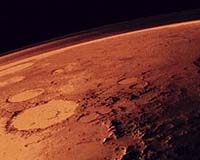 |
Pasadena CA (JPL) Aug 30, 2010 One of the instruments on a 2016 mission to orbit Mars will provide daily maps of global, pole-to-pole, vertical distributions of the temperature, dust, water vapor and ice clouds in the Martian atmosphere. The joint European-American mission, ExoMars Trace Gas Orbiter, will seek faint gaseous clues about possible life on Mars. This instrument, called the ExoMars Climate Sounder, will supply crucial context with its daily profiling of the atmosphere's changing structure. The European Space Agency and NASA have selected five instruments for ExoMars Trace Gas Orbiter. The European Space Agency will provide one instrument and the spacecraft. NASA will provide four instruments, including ExoMars Climate Sounder, which is coming from NASA's Jet Propulsion Laboratory, Pasadena, Calif. Two of the other selected instruments are spectrometers - one each from Europe and the United States - designed to detect very low concentrations of methane and other important trace gases in the Martian atmosphere. "To put the trace-gas measurements into context, you need to know the background structure and circulation of the atmosphere," said JPL's Tim Schofield, principal investigator for the ExoMars Climate Sounder. "We will provide the information needed to understand the distribution of trace gases identified by the spectrometers. We'll do this by characterizing the role of atmospheric circulation and aerosols, such as dust and ice, in trace-gas transport and in chemical reactions in the atmosphere affecting trace gases." The ExoMars Climate Sounder is an infrared radiometer designed to operate continuously, day and night, from the spacecraft's orbit about 400 kilometers (about 250 miles) above the Martian surface. It can pivot to point downward or toward the horizon, measuring temperature, water vapor, dust and ices for each 5-kilometer (3-mile) increment in height throughout the atmosphere from ground level to 90 kilometers (56 miles) altitude. Schofield and his international team have two other main goals for the investigation, besides aiding in interpretation of trace-gas detections. One is to extend the climate mapping record currently coming from a similar instrument, the Mars Climate Sounder, on NASA's Mars Reconnaissance Orbiter, which has been working at Mars since 2006. The orbital geometry of the Mars Reconnaissance Orbiter mission enables this sounder to record atmospheric profiles only at about 3 p.m. and 3 a.m. during the Martian day, except near the poles. The ExoMars Trace Gas Orbiter will fly an orbital pattern that allows the spacecraft to collect data at all times of day, at all latitudes. "We'll fill in information about variability at different times of day, and we'll add to the number of Mars years for understanding year-to-year variability," said Schofield. "The most obvious year-to-year change is that some years have global dust storms and others don't. We'd like to learn whether there's anything predictive for anticipating the big dust storms, and what makes them so variable from year to year." A third research goal is to assist future landings on Mars by supplying information about the variable density of the atmosphere. At a chosen landing site, atmospheric density can change from one day to the next, affecting a spacecraft's descent. "We want to provide background climatology for what to expect at a given site, in a given season, for a particular time of day, and also nearly real-time information for the atmospheric structure in the days leading up to the landing of a spacecraft launched after 2016," said Schofield. The 2016 ExoMars Trace Gas Orbiter is the first in a series of planned Mars mission collaborations of the European Space Agency and NASA. A variable presence of small amounts of methane in the Martian atmosphere has been indicated from orbital and Earth-based observations. A key goal of the mission is to gain a better understanding of methane and other trace gases that could be evidence about possible biological activity. Methane can be produced both biologically and without life. Besides the two spectrometers and the climate sounder, the orbiter's selected instruments include two NASA-provided imagers: a high-resolution, stereo, color imager, and a wide-angle, color, weather camera. The orbiter will also serve as a communications relay for missions on the surface of Mars and will carry a European-built descent-and-landing demonstration module designed to operate for a few days on the Mars surface. JPL, a division of the California Institute of Technology, manages NASA's roles in the mission.
Share This Article With Planet Earth
Related Links - Mars News and Information at MarsDaily.com Lunar Dreams and more
 Lost Into Space Goes The Martian Atmosphere
Lost Into Space Goes The Martian AtmosphereLeicester UK (SPX) Mar 15, 2010 Space physicists from the University of Leicester are part of an international team that has identified the impact of the Sun on Mars' atmosphere. Writing in the AGU journal Geophysics Research Letters, the scientists report that Mars is constantly losing part of its atmosphere to space. The new study shows that pressure from solar wind pulses is a significant contributor to Mars's atmosph ... read more |
|
| The content herein, unless otherwise known to be public domain, are Copyright 1995-2010 - SpaceDaily. AFP and UPI Wire Stories are copyright Agence France-Presse and United Press International. ESA Portal Reports are copyright European Space Agency. All NASA sourced material is public domain. Additional copyrights may apply in whole or part to other bona fide parties. Advertising does not imply endorsement,agreement or approval of any opinions, statements or information provided by SpaceDaily on any Web page published or hosted by SpaceDaily. Privacy Statement |